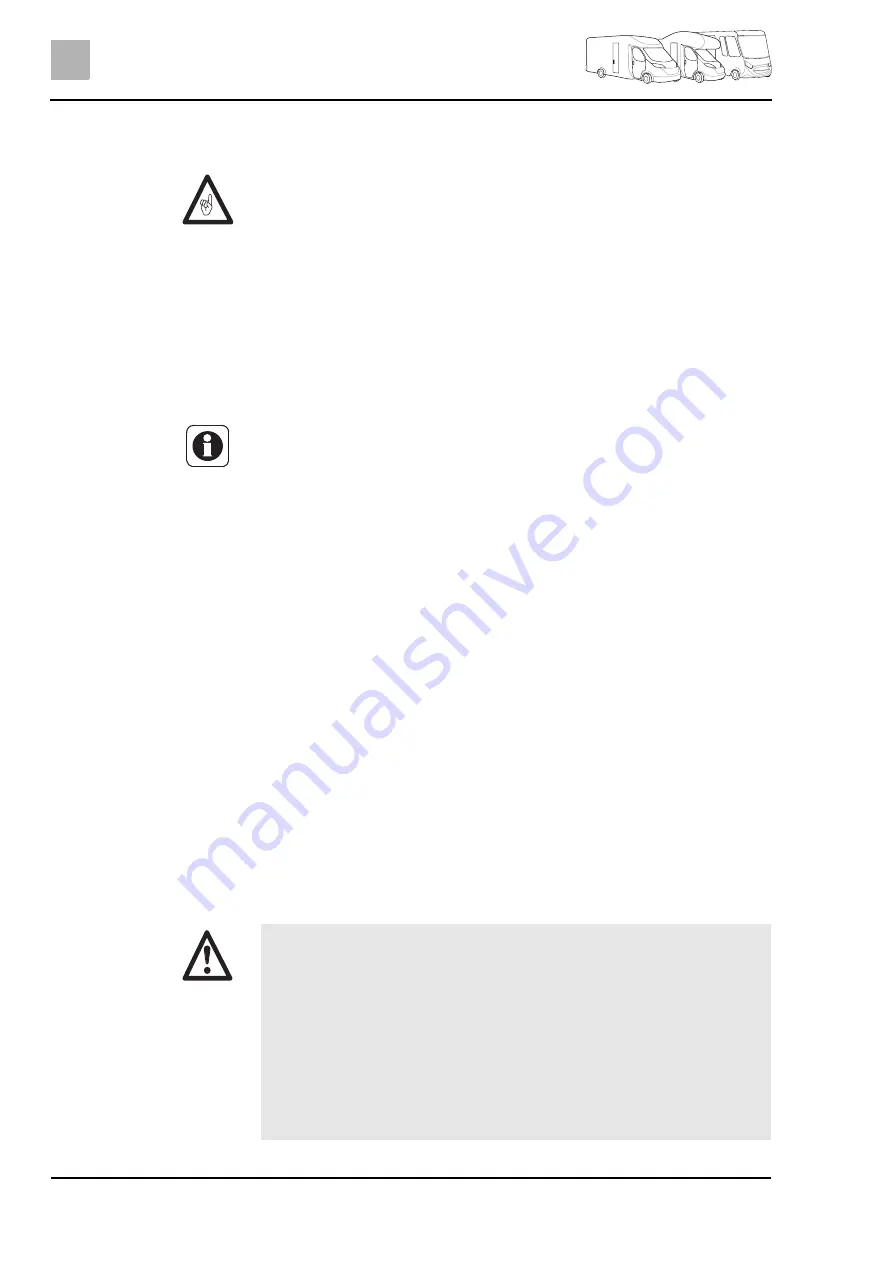
76
Capron - 04-17 - CAP-0017-01
EN
Electrical system
9
Discharging
The living area battery is discharged by the closed circuit current which some
electrical appliances continuously require.
The self-discharge rate of the battery is dependant on temperature. At 20 to
25 °C the self-discharge rate is approx. 3 % of the capacity per month. The
self-discharge rate will increase with rising temperatures: At 35 °C the self-dis-
charge rate is approx. 20 % of the capacity per month.
Low temperatures outside reduce the capacity available.
An older battery no longer has the complete capacity available.
The higher the number of active electrical appliances, the faster the energy of
the living area battery is consumed.
9.3.2
Charging batteries via a 240 V power supply
If the vehicle is connected to the 240 V power supply, the living area battery
and the starter battery are automatically charged by the charger module on the
transformer/rectifier. The starter battery is only charged with a float charge.
The charging current is adapted to suit the charging condition of the battery.
This ensures that it is not possible to overload the battery.
To make use of the maximum output from the charger module on the trans-
former/rectifier, switch off all electrical appliances during charging.
9.3.3
Charging batteries via the vehicle engine
When the vehicle engine is running, the vehicle alternator recharges the living
area battery and the starter battery. When the vehicle engine is switched off,
the batteries are automatically disconnected from one another by a relay in the
transformer/rectifier. This prevents the starter battery from being run down by
electrical appliances in the living area. The starting capability of the vehicle is
thus preserved. The charging condition of the living area battery or the starter
battery can be read on the panel.
9.3.4
Charging the starter battery
Z
Total discharge damages the battery.
Z
Recharge battery in good time.
Z
Appliances such as the refrigerator, charger, solar charge regulator, panel,
or similar, take power from the battery, even when the 12 V main switch is
turned off. Therefore disconnect the living area battery from the 12 V power
supply, if the vehicle will not be used for a long period of time.
X
The acid in the battery is poisonous and corrosive. Any contact with the
skin or the eyes is to be avoided. In the event of contact, rinse immedi-
ately with plenty of water (skin, eyes, clothes, objects) and seek medical
attention if necessary.
X
In the case of charging with an external charger there is danger of explo-
sion. Sparks can be caused by attaching the battery terminals. Only
charge the battery in a well ventilated area and away from naked flames
or possible sources of sparks. Batteries can develop and release gases
when they are charged.
X
Always remove the starter battery from the vehicle when charging it
using an external charger.
Summary of Contents for Capron A361
Page 4: ...Contents 4 Capron 04 17 CAP 0017 01EN ...
Page 6: ...6 Capron 04 17 CAP 0017 01EN Warranty 1 ...
Page 10: ...10 Capron 04 17 CAP 0017 01EN Introduction 2 ...
Page 32: ...32 Capron 04 17 CAP 0017 01EN Before the journey 4 ...
Page 72: ...72 Capron 04 17 CAP 0017 01EN Gas system 8 ...
Page 152: ...152 Capron 04 17 CAP 0017 01EN Helpful notes 16 ...
































